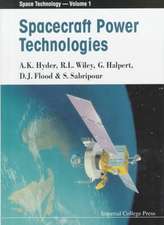Solar Origins of Space Weather and Space Climate
Editat de Irene González Hernández, Rudolf Komm, Alexei Pevtsov, John Leibacheren Limba Engleză Hardback – 18 iun 2014
This topical issue is based on the presentations given at the 26th National Solar Observatory (NSO) Summer Workshop held at the National Solar Observatory/Sacramento Peak, New Mexico, USA from 30 April to 4 May 2012. This unique forum brought together experts in different areas of solar and space physics to help in developing a full picture of the origin of solar phenomena that affect Earth’s technological systems. The articles include theory, model and observation research on the origin of the solar activity and its cycle, as well as a discussion on how to incorporate the research into space-weather forecasting tools.
This volume is aimed at graduate students and researchers active in solar physics and space science.
Previously published in Solar Physics, Vol. 289/2, 2014.
| Toate formatele și edițiile | Preț | Express |
|---|---|---|
| Paperback (1) | 557.82 lei 38-44 zile | |
| Springer – 3 sep 2016 | 557.82 lei 38-44 zile | |
| Hardback (1) | 644.95 lei 43-57 zile | |
| Springer – 18 iun 2014 | 644.95 lei 43-57 zile |
Preț: 644.95 lei
Preț vechi: 758.77 lei
-15% Nou
Puncte Express: 967
Preț estimativ în valută:
123.41€ • 129.18$ • 102.72£
123.41€ • 129.18$ • 102.72£
Carte tipărită la comandă
Livrare economică 31 martie-14 aprilie
Preluare comenzi: 021 569.72.76
Specificații
ISBN-13: 9781493911813
ISBN-10: 1493911813
Pagini: 254
Ilustrații: VI, 254 p. 22 illus., 9 illus. in color.
Dimensiuni: 155 x 235 x 22 mm
Greutate: 0.54 kg
Ediția:2014
Editura: Springer
Colecția Springer
Locul publicării:New York, NY, United States
ISBN-10: 1493911813
Pagini: 254
Ilustrații: VI, 254 p. 22 illus., 9 illus. in color.
Dimensiuni: 155 x 235 x 22 mm
Greutate: 0.54 kg
Ediția:2014
Editura: Springer
Colecția Springer
Locul publicării:New York, NY, United States
Public țintă
ResearchCuprins
Preface.- Buoyant Magnetic Loops Generated by Global Convective Dynamo Action.- Helioseismic Holography of an Artificial Submerged Sound Speed Perturbation and Implications for the Detection of Pre-emergence Signatures of Active Regions.- Active Regions with Superpenumbral Whirls and Their Subsurface Kinetic Helicity.- A Study of Connections Between Solar Flares and Subsurface Flow Fields of Active Regions.- A Full-Sun Magnetic Index from Helioseismology Inferences.- Far- and Extreme-UV Solar Spectral Irradiance and Radiance from Simplified Atmospheric Physical Models.- Survey and Merging of Sunspot Catalogs.- Sunspot Group Development in High Temporal Resolution.- Migration and Extension of Solar Active Longitudinal Zones.- Cyclic and Long-Term Variation of Sunspot Magnetic Fields.- Apparent Solar Tornado-Like Prominences.- Forecasting the Maxima of Solar Cycle 24 with Coronal Fe XIV Emission.- Coronal Magnetic Field Evolution from 1996 to 2012: Continuous Non-Potential Simulations.- Different Periodicities in the Sunspot Area and the Occurrence of Solar Flares and Coronal Mass Ejections in Solar Cycle 23-24.- Do Solar Coronal Holes Affect the Properties of Solar Energetic Particle Events?- From Predicting Solar Activity to Forecasting Space Weather: Practical Examples of Research-to-Operations and Operations-to-Research.
Notă biografică
Dr. Irene González Hernández was an astronomer at the National Solar Observatory. Her research interests included helioseismology, far side images and ring-diagram analysis.
Dr. Rudolf Komm is a Research Scientist at the National Solar Observatory and a leading expert in helioseismology, dynamics of the solar convection zone and the solar activity cycle.
Dr. Alexei Pevtsov is an astronomer at the National Solar Observatory. His research interests include solar magnetic fields and helicity, sunspots, the corona, CMEs and space weather.
Dr. John Leibacher is an astronomer at the National Solar Observatory and one of the Editors-in-Chief of the journal Solar Physics. His research interests include all aspects of helioseismology and atmospheric dynamics.
Dr. Rudolf Komm is a Research Scientist at the National Solar Observatory and a leading expert in helioseismology, dynamics of the solar convection zone and the solar activity cycle.
Dr. Alexei Pevtsov is an astronomer at the National Solar Observatory. His research interests include solar magnetic fields and helicity, sunspots, the corona, CMEs and space weather.
Dr. John Leibacher is an astronomer at the National Solar Observatory and one of the Editors-in-Chief of the journal Solar Physics. His research interests include all aspects of helioseismology and atmospheric dynamics.
Textul de pe ultima copertă
This topical issue is based on the presentations given at the 26th National Solar Observatory (NSO) Summer Workshop
held at the National Solar Observatory/Sacramento Peak, New Mexico, USA from 30 April to 4 May 2012. This unique forum brought together experts in different areas of solar and space physics to help in developing a full picture of the origin of solar phenomena that affect Earth’s technological systems. The articles include theory, model, and observation research on the origin of the solar activity and its cycle, as well as a discussion on how to incorporate the research into space-weather forecasting tools.
This volume is aimed at graduate students and researchers active in solar physics and space science.
Previously published in Solar Physics, Vol. 289/2, 2014.
held at the National Solar Observatory/Sacramento Peak, New Mexico, USA from 30 April to 4 May 2012. This unique forum brought together experts in different areas of solar and space physics to help in developing a full picture of the origin of solar phenomena that affect Earth’s technological systems. The articles include theory, model, and observation research on the origin of the solar activity and its cycle, as well as a discussion on how to incorporate the research into space-weather forecasting tools.
This volume is aimed at graduate students and researchers active in solar physics and space science.
Previously published in Solar Physics, Vol. 289/2, 2014.
Caracteristici
Presents an overview of recent research on the original of solar phenomena that affect Earth’s technological systems Includes articles on how to incorporate the research into space-weather forecasting tools
















